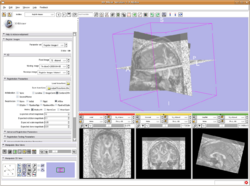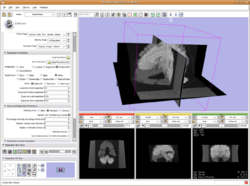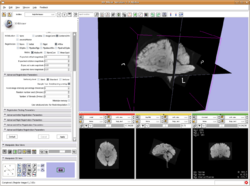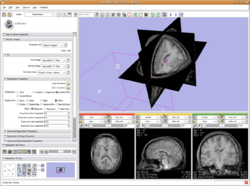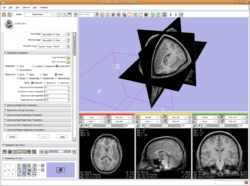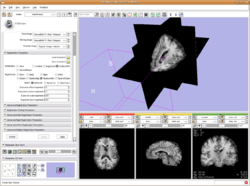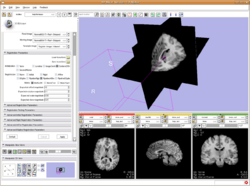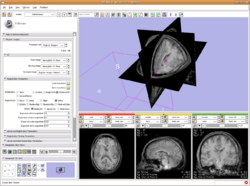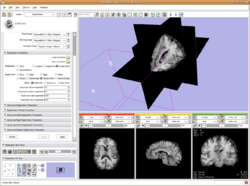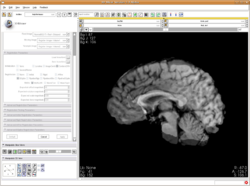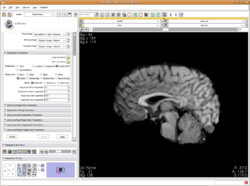ITK Registration Optimization
Contents
- 1 Slicer3 Module: RegisterImages
- 2 Background Research
- 3 Publications
- 4 Quick Links
- 5 Workplan
- 6 Performance Testing Results
- 7 Events
- 8 Related Pages
- 9 Performance Measurement
Slicer3 Module: RegisterImages
The RegisterImages module is the product of the research discussed below.
Major Features
The major features of the module include:
- Default parameters register many full-head and skull-stripped MRI: rigid, affine, and BSpline
- Offers a complete, pipeline-based registration solution
- Load and apply existing transforms
- Compute rigid, affine, and bspline transforms in sequence with a single command
- Intuitive parameters
- Instead of setting obscure "scales" for parameters, you set global values for "Expected Offset", "Expected Rotation", ... to indicate how much mis-registration is anticipated in the data being registered
- MinimizeMemory option provides a way to compute bspline registrations using a dense set of control points and a large number of samples on "normal" computers (albeit computation time increases)
- SampleFromOverlap option allows images of vastly different sizes to be registered
- Helps to avoid (but does not completely eliminate) the annoying ITK exception, "too many samples falls outside of the image"
- Incorporates testing
- Specify a baseline image, and modules will perform the requested registration, compare its results with the baseline image, and return success/failure
- Based on an extensible and re-usable class structure.
Each of these features is discussed next.
Head MRI Registration
Example 1: Problem Cases
- Registers images which were not well resolved (or produced seg-faults) using other slicer registration modules:
Difficult affine registration, Same subject, Different protocols: T2 and Fractional Anisotropy
Difficult affine registration, Same subject, Different protocols: T1 and Gradient
Example 2: Affine Registration
- Task:
- Affine registration of head MRI from two different subjects
- Data:
- Using cases UNC-Healthy-Normal002 (fixed) and UNC-Healthy-Normal004 (moving)
- Data provided by Dr. Bullitt at UNC.
- Data is available from Kitware's MIDAS archive at http://hdl.handle.net/1926/542
- Data can be automatically downloaded into ${RegisterImages_BINARY_DIR}/Testing/Data directory by enabling the CMake variable "BUILD_REGISTER_IMAGES_REAL_WORLD_TESTING"
- Warning this also enables additional tests that can take 4+ hours to complete.
- To see the code for automatically downloading from MIDAS (via svn), see Slicer3/Applications/CLI/RegisterImagesModule/Applications/CMakeLists.txt
Affine registration of head MRI from two difference subjects
Affine registration of skull-stripped head MRI from two difference subjects
Example 3: BSpline Registration
- Task:
- BSpline registration of head MRI from two different subjects
- Data:
- Using cases UNC-Healthy-Normal002 (fixed) and UNC-Healthy-Normal004 (moving)
- Data provided by Dr. Bullitt at UNC.
- Data is available from Kitware's MIDAS archive at http://hdl.handle.net/1926/542
- Data can be automatically downloaded into ${RegisterImages_BINARY_DIR}/Testing/Data directory by enabling the CMake variable "BUILD_REGISTER_IMAGES_REAL_WORLD_TESTING"
- Warning this also enables additional tests that can take 4+ hours to complete.
- To see the code for automatically downloading from MIDAS (via svn), see Slicer3/Applications/CLI/RegisterImagesModule/Applications/CMakeLists.txt
BSpline, Default Options, Different Subjects, Same Protocol, Head MRI
BSpline, Dense Control-Point Grid, Different Subjects, Same Protocol, Head MRI
BSpline, Default Options and Dense Control-Point Grid, Different Subjects, Same Protocol, Skull-Stripped Head MRI
Pipeline Registration
The module implements a registration pipeline. The steps in that pipeline are as follows:
- Step 1: Loaded transform
- You may load a pre-computed transform to initialize the registration.
- If one is loaded, it is immediately applied (i.e., the moving image is resampled)
- Step 2: Initial registration
- Options are:
- None (sets the center of rotation to the center of the moving image)
- Landmark (uses N-pairs of landmarks (passed as vectors) and a least-squared error metric to register the images using a rigid transform
- Image Centers (shifts the images to align their centers)
- Centers of Mass (shifts the images to align their centers of mass)
- Second Moments (shifts and rotates the images to align the 1st and 2nd moments)
- Options are:
- Step 3: Registration
- Options are:
- None (applies the loaded transforms)
- Initial
- computes and applies the initial transform to the loaded registrations)
- Rigid
- computes a rigid transform and then applies it to the loaded registrations
- Affine
- computes an affine transform and then applies it to the loaded registrations
- BSpline
- computes a bspline transform and then applies it to the loaded registrations
- PipelineRigid
- computes a rigid transform (initialized using the results from the initial registration) and then applies it to the loaded registrations
- PipelineAffine
- computes a rigid transform (initialized using the results from the initial registration), uses those results to initialize and compute an affine transform, and then applies it to the loaded registrations
- PipelineBSpline
- computes a rigid transform (initialized using the results from the initial registration), uses those results to initialize and compute an affine transform, and then applies it to the loaded registrations, THEN computes and applies a BSpline transform
- Options are:
Intuitive Parameters
Instructions for Enabling the RegisterImages module
You need to change the build scripts (and perhaps their parameter files) to perform a cvs checkout of itk. There are two sets of instructions, one for those building using the getbuildtest script and one for those building using the getbuildtest2 script.
Using getbuildtest.tcl
If you are using getbuildtest.tcl script
- In the file Slicer3/slicer_variables.tcl
- Line 82 (or there about): change it to
SET ::ITK_TAG "HEAD"
Using getbuildtest2.tcl
If you are using getbuildtest2.tcl
- In the file Slicer3/slicer_variables2.tcl
- Line 83 (or there about): change it to
SET ::ITK_TAG "HEAD"
- In the file Slicer3/Scripts/genlib2.tcl
- The svn checkout needs to instead do a cvs update. You need to have cvs in your system path. You should edit the runcmd svn line to instead read:
runcmd cvs -d :pserver:anonymous@www.itk.org:/cvsroot/Insight co Insight
Done
- With the above completed, perform getbuildtest.tcl or getbuildtest2.tcl as normal.
- Please direct questions/comments to the slicer developers' list.
Class structure
- Try it, you'll like it.
- Follows the coding style of itk
- Limited comments, but meaningful variable names
- No documentation is provided or planned - don't even ask.
Background Research
Goals
There are two components to this research
- Identify registration algorithms that are suitable for non-rigid registration problems that are endemic to NA-MIC
- Develop implementations of those algorithms that take advantage of multi-core and multi-processor hardware
Steps involved
- Modify ITK's registration framework to support oriented images
- Modify ITK's registration framework to be thread safe
- Develop multi-threaded versions of select registration modules
- Make everything backward compatible with ITK's existing registration methods and framework
- Deliver in ITK
- Develop helper classes and write IJ article
Target date for these deliverables: Jan 1, 2008
Planned follow-on work
Devise a new metric for MI registration
Ideas for a new metrick
- If we always use every voxel for the metric, then we can cache the weights by the voxel's position wrt the adjacent control points. For example, for Kilian's situation of a control point every 2 voxels, then there really are only a few unique weight sets that are repeated throughout the volume. Luis had already brought up a variation on this idea.
- This method could also be combined with the rule to not evaluate voxels or control points that fall on background voxels. This too has been discussed, but such a rule makes multi-threading tricky in that we don't want to waste threads by allocating them to image regions that contain only background voxels.
- The metric could be closely tied to a multiresolution registration scheme. In fact, the grid and the image resolutions should perhaps be linearly related. That is, we could tie the metric computation to the resolution of the deformation grid by subsampling the image. There are situations where this is not a right thing to do (just because the grid is coarse doesn't mean that a small movement isn't important); HOWEVER, as part of a multiresolution registration strategy, it is perhaps the viable option. This would need to be evaluated on the data.
Known issues
- There are still many ways in which the speed of various registrations methods in ITK can be improved.
- PLEASE ENTER YOUR SUGGESTIONS BELOW
- Have "don't-care" regions in which bspline control points are processed/don't move
- e.g., no need to adjust ones that only contain background
- Have "don't-care" regions in which bspline control points are processed/don't move
Status and News
- Have developed mult-threaded registration metrics in ITK
- Lead to the discovery that ITK's registration framework was not thread safe.
- Making ITK's registration framework thread safe is conceptually a bug fix for ITK.
- The incomplete implementation of oriented images in ITK has greatly extended the time and effort needed for this project.
- Fixing this must be done in a manner that maintains ITK's backward compatibility.
- This is a major effort involving approximately 50,000 lines of new code and over 400 new tests in ITK.
- We have chosen to spend the time to integrate with ITK because it will serve the broader community, it will benefit from the support of the broader community, it will avoid having to incorporate another SVN checkout into Slicer's build process, and it will keep us from having to maintain and monitor separate dashboards for this effort.
- Weekly tcons, Monday, 10am
- Luis Ibanez, Matt Turek, Stephen Aylward
- Active proposal to the ITK community:
- Project plan
- IJ article on oriented images and registration in ITK
- http://www.insight-journal.org/dspace/bitstream/1926/1293/2/Brooks_Arbel_FastOrientedImage_V1.pdf
- Solution presented by the authors is closely related to the changes being made in ITK
Publications
- Aylward, Stephen; Jomier, Julien; Barre, Sebastien; Davis, Brad; Ibanez, Luis, "Optimizing ITK’s Registration Methods for Multi-processor, Shared-Memory Systems." MICCAI Open Source and Open Data Workshop, 2007 (Download PDF)
Quick Links
- Dashboard for this project
- Dashboard for BatchMake
- Batchboard (nightly experiment results) for this project
- BWH Neuroimaging Analysis Center (NAC), 2007-2008: Grid Enabled ITK
Algorithmic Requirements and Use Cases
- Requirements
- relatively robust, with few parameters to tweak
- runs on grey scale images
- has already been published
- relatively fast (ideally speaking a few minutes for volume to volume).
- not patented
- can be implemented in ITK and parallelized.
- Use-cases
- Intersubject mapping
- Example data set (Kilian)
- fMRI to hi-res brain morphology mapping
- Example data set (Steve Pieper)
- DTI: components of the diffusion tensor
- Example data (Sylvain)
- Intersubject mapping
Hardware Platform Requirements and Use Cases
- Requirements
- Shared memory
- Single and multi-core machines
- Single and multi-processor machines
- AMD and Intel - Windows, Linux, and SunOS
- Use-cases
- Intel Core2Duo
- Intel quad-core Xeon processors, Visual Studio 8, Windows Vista (Kitware: redwall)
- 6 CPU Sun, Solaris 8 (SPL: vision)
- 12 CPU Sun, Solaris 8 (SPL: forest and ocean)
- 16 core Opteron (SPL: john, ringo, paul, george)
- 16 core, Sun Fire, AMDOpteron (UNC: Styner)
Data
- Now distributed with CVS
Workplan
Establish testing and reporting infrastructure
- Identify timing tools
- Cross platform and multi-threaded
- Timing and profiling
- Develop performance dashboard for collecting results
- Each test will report time and accuracy to a central server
- The performance of a test, over time, for a given platform can be viewed on one page
- The performance of a set of tests, at one point in time, for all platforms can be viewed on one page
Develop tests
- Develop modular tests
- Develop complete registration solutions for use cases
ITK Optimization
- Target bottlenecks
- Multi-thread metric calculation
- Initial target is MattesMutualInformationImageToImageMetric
- Optimize code
- Sacrifice some memory and algorithm initialization speed to gain algorithm operation speed increases
- Call multi-threaded functions when possible
- Multi-thread metric calculation
- Integrate metrics with transforms and interpolators for tailored performance
Example Results: MattesMutualInformationImageToImageMetric
Example of Optimizations Employed
- GetValue
- Added multi-threading to GetValue function
- Partitions the samples - thereby distributes the computation of the transforms and interpolations across threads
- Added the pre-computation of the FixedImageMarginalPDF for the sample to reduce the need for the thread mutex lock
- Required the concept of an AdjustedFixedImageMarginalPDF that is updated when a fixed image voxel does not map into the moving image and thereby isn't valid for the current computations. By only updating when samples are missed, mutex lock to update a cross-thread data structure is needed less often.
- Each thread now has its own copy of the joinPDF. After threads complete, jointPDFs from each thread are summed. This eliminates mutex from the main loop over samples.
- Added multi-threading to GetValue function
Results
- Speedup on a dual-core system is about 30% (reduction in computation time) when using linear transform and linear interpolation and about 45% when using bspline transform and bspline interpolation.
Performance Testing Results
GetValue Test at Identity Parameters
// Print out a line with the test information
std::cout << "GetValue2,";
std::cout << metric->GetNameOfClass() << "," << interpolator->GetNameOfClass();
std::cout << "," << transform->GetNameOfClass();
// Make a time probe
itk::TimeProbe timeProbe;
// Run at the identity transform parameters.
unsigned int numIters = 100;
timeProbe.Start();
for (unsigned int iter = 0; iter < numIters; iter++)
{
value = metric->GetValue( identityParameters );
}
timeProbe.Stop();
// Print out the number of samples
std::cout << "," << metric->GetNumberOfPixelsCounted();
// Print out the time result.
std::cout << "," << timeProbe.GetMeanTime()/numIters << std::endl;
GetValueAndDerivative Test at Identity Parameters
// Print out a line with the test information
std::cout << "GetValueAndDerivative2,";
std::cout << metric->GetNameOfClass() << "," << interpolator->GetNameOfClass();
std::cout << "," << transform->GetNameOfClass();
// Make a time probe
itk::TimeProbe timeProbe;
// Evaluate at the identity transform;
unsigned int numIters = 100;
timeProbe.Start();
for (unsigned int iter = 0; iter < numIters; iter++)
{
metric->GetValueAndDerivative( identityParameters, value, derivative );
}
timeProbe.Stop();
// Print out the number of samples
std::cout << "," << metric->GetNumberOfPixelsCounted();
// Print out the time result.
std::cout << "," << timeProbe.GetMeanTime()/numIters << std::endl;
Preliminary Results
January 5, 2008 - Note: "Opt" results are not using the OptLinearInterpolateImageFunction.
- MattesMI GetValue Results
- MattesMI, b-spline interpolation and transform, GetValue Results
- MeanSquares GetValue Results
- MattesMI GetValueAndDerivative Results
- MattesMI, b-spline interpolation and transform, GetValueAndDerivative Results
- MeanSquares GetValueAndDerivative Results
Events
- April 6, 2007: TCon
- April 12, 2007: TCon
- April 18, 2007: TCon
- May 1, 2007: TCon
- June 27, 2007: NAMIC Programmers' Week
- January, 2008: NAMIC AHM
Related Pages
- Non Rigid Registration
- Slicer3:Performance_Analysis
- User:Barre/ITK Registration Optimization
- Testing and ITK Backward Forward Compatibility
Performance Measurement
- LTProf - simple profilter for Windows - Shareware
- Intel's VTune for Linux ($)
- TAU
- Threadmon: Thread usage/blockage
- TotalView ($)
- PerfSuite (POSIX Threads)
- GProf work-around for multi-threaded apps
- References on multi-threaded profiling and code optimization
